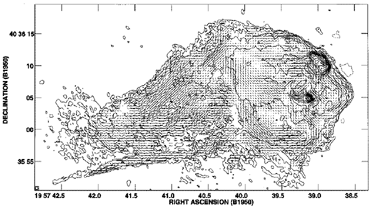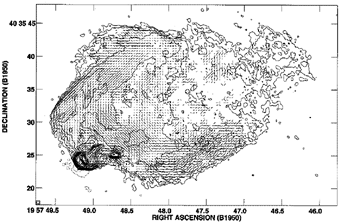


7.2. Fractional Polarization and Projected Field Morphology
Multi-frequency radio continuum polarimetric imaging determines both the
fraction of the total intensity which is linear polarized at a given
frequency, and after a proper correction has been made for Faraday
rotation as discussed below, the projected magnetic field structure in
the radio source. The theoretical maximum fractional polarization, FP,
for optically thin synchrotron emission from a population of
relativistic electrons with a power-law energy distribution and an
isotropic pitch angle distribution in a uniform magnetic field is: FP =
(1 -  ) / (5/3 -
) / (5/3 -
 ), or 72% for
), or 72% for
 = -0.7
(Pacholcyzk 1970). Fractional polarizations are high in Cygnus A, with
typical values between 10% and 40%, and reaching as high as 70%
in the jet and hotspots at high resolution
(Carilli et al. 1989a).
= -0.7
(Pacholcyzk 1970). Fractional polarizations are high in Cygnus A, with
typical values between 10% and 40%, and reaching as high as 70%
in the jet and hotspots at high resolution
(Carilli et al. 1989a).
The projected magnetic field distribution across the radio lobes is shown in figure 9. The projected fields generally follow parallel to the edges of the source, to the bright ridges in the hotspots, to the filamentary structure in the lobes, and along the jet.

|

|
Figure 9. The contours are of total intensity from Cygnus A at 8 GHz, 0.35" resolution. The vectors show the projected magnetic field distribution across the source derived from the polarized emission after correction for Faraday rotation, reproduced from Perley and Carilli (1996). |
Laing (1980) presents an analytic model for magnetic fields in radio galaxies which explains very nicely the observed fractional polarization and projected field structure in Cygnus A. His model involves simple kinematic dynamo processes in the radio source, i.e. shear and/or compression by turbulent fluid motions of a magnetic field which is `frozen-in' to the fluid due to the very high conductivity of a collision-less plasma. Compression and shear can result in the creation of `Laing cells' from a fully tangled initial field distribution. Such cells correspond to regions of highly anisotropically tangled field where one dimension of the turbulence is `re-organized' by compression or shear. In certain projections this can result in observed fractional polarizations approaching the theoretical maximum. The simple analytic model of Laing has been verified by 3D hydrodynamic simulations of radio jets with passive magnetic fields, including the field morphology in the jets, hotspots, and filamentary structure in the lobes (Clarke 1992, Mathews and Scheuer 1991, Cox et al. 1991).
Perley and Carilli (1996) present polarization images of Cygnus A at 8 GHz, 0.4" resolution. They find very high fractional polarizations in the radio lobes, approaching 70% in some areas, and projected fields which follow parallel to the axis of the radio lobes. The implication is a very well ordered field in the lobes with the dominant field component projecting along the long axis of the lobe, as expected for example if the field is stretched by shear flow down the lobes. This suggests that the fluid dynamics in the lobes is not magnetically dominated (Blandford 1996).